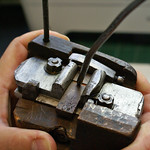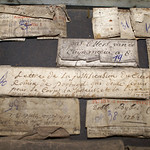‘Having learned and memorised the true proportions of roman letter as taught in the manuals of Moille, Pacioli and others, the goldsmiths, punch-cutters and printers relied on their eyes and not upon their measuring tools.’, according to Stanley Morison in Fra Luca de Pacioli of Borgo S. Sepolcro (1933).
Really? Did the Italian and French Renaissance goldsmiths and engravers purely rely on their eyes when they cut the first roman types, as Morison suggested, or did they actually use different, standardized, systematized, and unitized methods, perhaps inspired by the manuals of Moille, Pacioli and others? Morison’s statement seems to mystify the qualities of punchcutters such as Nicolas Jenson, Francesco Griffo, Claude Garamont, and Robert Granjon. Allen Hutt describes these qualities in Fournier, the Compleat Typographer (London, 1972) as ‘[…] some indefinable talent in the best punch-cutters and type designers who aimed and continue to aim at optical harmony.’ However, if this talent can be distinguished, then it should be possible to define it also, I reckon.
Although Morison’s statement on the punchcutters and their eyes seems to be nothing more than an assumption, it is actually generally embraced by the type world. Type historians connect the attempts to reconstruct the Roman imperial capitals by Renaissance artists and scholars like Feliciano, Pacioli, and, of course, Albrecht Dürer, with the Romain du Roi, but the appliance of geometric systems in the work of the Renaissance punchcutters seems to be completely out of order.
Is it possible that the early punchcutters, who were engravers or gold smiths from origin, i.e., craftsmen, only used their eyes in a profession that requires standardization? For example, why would they have ignored conventions such as the golden ratio that seem to have been applied throughout the Renaissance world of art? Was it because of technical limitations, or did Jenson, Griffo, Garamont, Granjon, and consorts have such trained eyes that they applied ‘divine’ proportions on the fly?
Every collection of graphemes representing an alphabet has its own rules, defined by their specific harmonics, patterns, and dynamics. The shapes of the graphemes can be the result of either a long or a short evolution; their domination can be the result of a fixation at a certain moment in history. When the graphemes are commonly accepted they define the rules for the conditioning of their users, i.e., readers, and their producers, i.e., type designers.
One wonders whether Fournier was aware of the fact that what the eye sees is merely the result of conditioning when he commented in his Manuel Typographique from 1764–1766 on the attempts of Jaugeon and co. to standardize the design of the Romain du Roi: ‘These gentlemen would have been well advised to a single rule which they established, which is chiefly to be guided by the eye, the supreme judge […].’
Conditioning is based on conventions and conditioning preserves conventions. Thus the snake bites its own tail; to able to use one’s ‘eye’ like Fournier advocated, one has to be educated to look at type in the same way. What is considered to be harmonic, rhythmic, and æsthetic in type is merely the result of conditioning, i.e., cultural habituation. Familiarity is an important factor for the preservation of conventions; the appreciation of certain structures in, for example, visual art, architecture, typography, or music also depends on this.
Related Notes
Recent Posts
Images on Flickr




